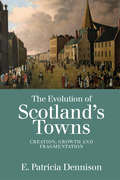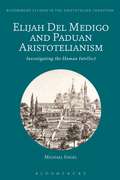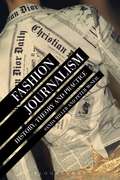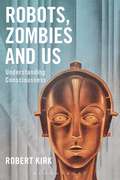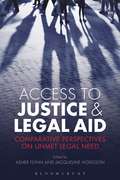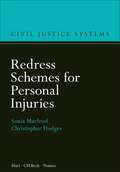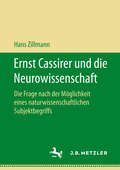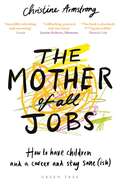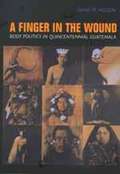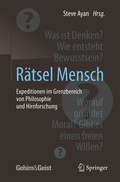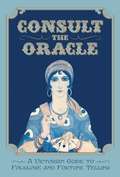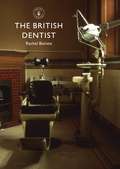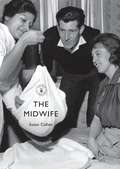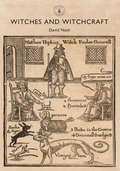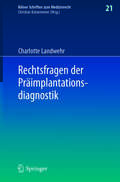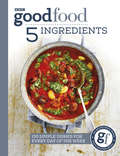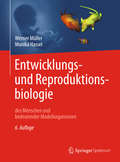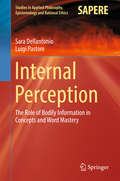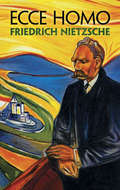- Table View
- List View
The Evolution of Scotland’s Towns: Creation, Growth and Fragmentation
by Patricia DennisonExamines Francoist and Post-Francoist Spanish cinema through the lens of kitsch aesthetics
Elijah Del Medigo and Paduan Aristotelianism: Investigating the Human Intellect (Bloomsbury Studies in the Aristotelian Tradition)
by Michael EngelElijah Del Medigo (1458-1493) was a Jewish Aristotelian philosopher living in Padua, whose work influenced many of the leading philosophers of the early Renaissance. His Two Investigations on the Nature of the Human Soul uses Aristotle's De anima to theorize on two of the most discussed and most controversial philosophical debates of the Renaissance: the nature of human intellect and the obtaining of immortality through intellectual perfection.In this book, Michael Engel places Del Medigo's philosophical work and his ideas about the human intellect within the context of the wider Aristotelian tradition. Providing a detailed account of the unique blend of Hebrew, Islamic, Latin and Greek traditions that influenced the Two Investigations, Elijah Del Medigo and Paduan Aristotelianism provides an important contribution to our understanding of Renaissance Aristotelianisms and scholasticisms. In particular, through his defense of the Muslim philosopher Averroes' hotly debated interpretation of the De anima and his rejection of the moderate Latin Aristotelianism championed by the Christian Thomas Aquinas, Engel traces how Del Medigo's work on the human intellect contributed to the development of a major Aristotelian controversy.Investigating the ways in which multicultural Aristotelian sources contributed to his own theory of a united human intellect, Elijah Del Medigo and Paduan Aristotelianism demonstrates the significant impact made by this Jewish philosopher on the history of the Aristotelian tradition.
Fashion Journalism: History, Theory, and Practice
by Sanda Miller Peter McNeilFashion is all around us, and so too is fashion journalism. Discussions of fashion proliferate in an ever-increasing range of media, from newspapers and magazines to tweets and TV programs. Fashion Journalism: History, Theory and Practice is an accessible, comprehensive guide to writing about fashion in any form, whether in style blogging, magazine interviews, news reportage or art reviews.Exploring what sets fashion journalism apart from other forms of journalistic writing, the book features a wide range of global fashion case studies, from Carmel Snow's reporting on Dior's 'New Look' to 1970s responses to Yves Saint Laurent, and Diana Vreeland's role as a fashion editor. Through a series of engaging exercises, you will learn how to find inspiration, carry out successful research, structure your work logically, use a style appropriate to your readership, and to make the leap from descriptive writing to informed analysis and criticism. Engaging and clearly written, Fashion Journalism examines how recent technological developments are shaping and driving fashion journalism, and delves into the theory and practice of writing about fashion.
Robots, Zombies and Us: Understanding Consciousness
by Robert KirkCould robots be genuinely intelligent? Could they be conscious? Could there be zombies? Prompted by these questions Robert Kirk introduces the main problems of consciousness and sets out a new approach to solving them. He starts by discussing behaviourism, Turing's test of intelligence and Searle's famous Chinese Room argument, and goes on to examine dualism – the idea that consciousness requires something beyond the physical – together with its opposite, physicalism. Probing the idea of zombies, he concludes they are logically impossible. Having presented the central problems, he sketches his solution: a version of functionalism, according to which consciousness consists in the performance of functions.While there is wide agreement among philosophers about what the main problems of consciousness are, there is little agreement on how to go about solving them. With this powerful case for his version of functionalism, Kirk offers an engaging introduction to both the problems and a possible solution.
Access to Justice and Legal Aid: Comparative Perspectives on Unmet Legal Need
by Asher Flynn Jacqueline HodgsonThis book considers how access to justice is affected by restrictions to legal aid budgets and increasingly prescriptive service guidelines. As common law jurisdictions, England and Wales and Australia, share similar ideals, policies and practices, but they differ in aspects of their legal and political culture, in the nature of the communities they serve and in their approaches to providing access to justice. These jurisdictions thus provide us with different perspectives on what constitutes justice and how we might seek to overcome the burgeoning crisis in unmet legal need. The book fills an important gap in existing scholarship as the first to bring together new empirical and theoretical knowledge examining different responses to legal aid crises both in the domestic and comparative contexts, across criminal, civil and family law. It achieves this by examining the broader social, political, legal, health and welfare impacts of legal aid cuts and prescriptive service guidelines. Across both jurisdictions, this work suggests that it is the most vulnerable groups who lose out in the way the law now operates in the twenty-first century. This book is essential reading for academics, students, practitioners and policymakers interested in criminal and civil justice, access to justice, the provision of legal assistance and legal aid.
Redress Schemes for Personal Injuries (Civil Justice Systems)
by Sonia Macleod Christopher HodgesThis ground-breaking book takes a fresh look at potential non-litigation solutions to providing personal injury compensation. It is the first systematic comparative study of such a large number – over forty – of personal injury compensation schemes. It covers the drivers for their creation, the frameworks under which they operate, the criteria and thresholds used, the compensation offered, the claims process, statistics on throughput and costs, and analysis of financial costings. It also considers and compares the successes and failings of these schemes. Many different types of redress providers are studied. These include the comprehensive no-blame coverage offered by the New Zealand Accident Compensation Corporation; the widely used Patient, Pharmaceutical, Motor Accident and Workers Compensation Insurance systems of the Nordic states; the far smaller issue-focused schemes like the UK Thalidomide and vCJD Trusts; vaccine damage schemes that exist in many countries; as well as motor vehicle schemes from the USA. Conclusions are drawn about the functions, essential requirements, architecture, scope, operation and performance of personal injury compensation systems. The relationships between such schemes, the courts and regulators are also discussed, and both calls and need for reforms are noted.Noting the wide calls for reform of NHS medical negligence litigation within the UK, and its replacement with a no blame approach, the authors' findings outline options for future policy in this area. This major contribution builds on general shifts from courts to ADR, and from blame to no blame in regulation, and is a work that has the potential to have a major impact on the field of personal injury redress.With contributions by Raymond Byrne, Claire Bright, Shuna Mason, Magdalena Tulibacka, Matti Urho, Mary Walker and Herbert Woopen.
Ernst Cassirer und die Neurowissenschaft: Die Frage nach der Möglichkeit eines naturwissenschaftlichen Subjektbegriffs
by Hans ZillmannHans Zillmann leistet einen philosophischen Beitrag zur Frage nach den Möglichkeiten und Grenzen eines neurowissenschaftlichen Subjektbegriffs. Anhand der Symbolphilosophie Ernst Cassirers und anderer Ansätze zeigt er, dass wissenschaftliche Subjektbeschreibungen auf zwei Ebenen kontextuell sind: Sowohl das Subjekt – als Gegenstand der Forschung – als auch die neurowissenschaftliche Theoriebildung sind in einen kultur-historischen Kontext eingebettet. In der vorliegenden Schrift werden die Notwendigkeit eines ausgleichenden Dialogs zwischen Philosophie und Neurowissenschaften sowie die Kontextualität herausgearbeitet.
The Mother of All Jobs: How to Have Children and a Career and Stay Sane(ish)
by Christine ArmstrongIt's time for a different conversation about working and parenting. As our working days get ever longer and our phones keep so many of us glued to work, the needs of our children and the world of school and childcare has not changed at all. School summer holidays are still longer than our annual leave. Working mothers everywhere are tearing themselves apart, trying to meet the needs of their children, their relationships and their careers and too often feeling like they are failing. So is there a solution? When Christine Armstrong became a mother, it never occurred to her that she would want to give up her job. But the truth is, combining work and small kids is hard, and when Christine tried it, she found herself desolate with misery. Determined to find a way forward, she looked for answers by interviewing other working mums and found that she wasn't alone. The Mother of All Jobs brings together the wisdom of the women who opened up about everything (and we mean everything) into a manifesto for happy professional families. Ignoring the glossy lives presented on social media, this book shows that, while it's not always pretty, working parents can thrive if they have the knowledge others learnt the hard way.
A Finger in the Wound: Body Politics in Quincentennial Guatemala (PDF)
by Diane M. NelsonMany Guatemalans speak of Mayan indigenous organizing as "a finger in the wound." Diane Nelson explores the implications of this painfully graphic metaphor in her far-reaching study of the civil war and its aftermath. Why use a body metaphor? What body is wounded, and how does it react to apparent further torture? If this is the condition of the body politic, how do human bodies relate to it—those literally wounded in thirty-five years of war and those locked in the equivocal embrace of sexual conquest, domestic labor, mestizaje, and social change movements? Supported by three and a half years of fieldwork since 1985, Nelson addresses these questions—along with the jokes, ambivalences, and structures of desire that surround them—in both concrete and theoretical terms. She explores the relations among Mayan cultural rights activists, ladino (nonindigenous) Guatemalans, the state as a site of struggle, and transnational forces including Nobel Peace Prizes, UN Conventions, neo-liberal economics, global TV, and gringo anthropologists. Along with indigenous claims and their effect on current attempts at reconstituting civilian authority after decades of military rule, Nelson investigates the notion of Quincentennial Guatemala, which has given focus to the overarching question of Mayan—and Guatemalan—identity. Her work draws from political economy, cultural studies, and psychoanalysis, and has special relevance to ongoing discussions of power, hegemony, and the production of subject positions, as well as gender issues and histories of violence as they relate to postcolonial nation-state formation.
Rätsel Mensch - Expeditionen im Grenzbereich von Philosophie und Hirnforschung
by Steve AyanIn diesem Buch geht es um die großen Fragen an der Schnittstelle von Philosophie, Psychologie und Hirnforschung: Wer bin ich? Wie handle ich richtig? Wie entsteht Bewusstsein? Gibt es einen freien Willen? Wie hängen Sprache und Denken, Gefühle und Moral, Körper und Geist miteinander zusammen? Was ist der Sinn des Lebens? Nie zuvor beschäftigten sich so viele Menschen mit solch grundlegenden Fragen des Lebens: Philosophie ist in! Und ihre Antworten werden zunehmend auch aus der neurowissenschaftlichen Forschung inspiriert.Der Brückenschlag zwischen den Disziplinen ist das Markenzeichen der Zeitschrift Gehirn und Geist, aus deren Fundus die Beiträge dieses Buches stammen. Den Leser erwarten Artikel, Interviews und Essays von renommierten Wissenschaftlern und Fachjournalisten, ergänzt um Glossare sowie weiterführende Literatur- und Webtipps. Die Bandbreite der Themen reicht von den Grundlagen der Philosophie des Geistes bis zu Problemen des Neuroenhancement, von der Kontroverse um die Deutungsmacht der Hirnforschung bis zu Fragen von Moral und Ethik.Lassen Sie sich von der Denklust und Erkenntnisfreude der hier versammelten Autorinnen und Autoren anstecken und entschlüsseln Sie mit ihnen gemeinsam das Rätsel Mensch.
Fehlgeburten Totgeburten Frühgeburten: Ursachen, Prävention und Therapie
by Bettina TothDieses Buch hilft niedergelassenen Gynäkologen sowie klinisch tätigen Ärzten im Umgang mit den kritischen Ereignissen in der Geburtshilfe. Ausgehend von der Darstellung möglicher anatomischer, genetischer, endokrinologischer und/oder immunologischer Grundlagen und Ursachen gehen die Autoren praxisnah auf die diagnostischen und therapeutischen Möglichkeiten ein. Auch erfährt der Leser welche präventiven Maßnahmen und Ansätze zur Vermeidung ergriffen werden können. Neben klinisch-medizinischem Wissen werden auch der psychologische Umgang und die Betreuung von betroffenen Frauen thematisiert.
Consult the Oracle: A Victorian Guide to Folklore and Fortune Telling
by Gabriel Nostradamus"If you sing before breakfast you will cry before supper...' In their own words, what it meant for Victorians to dream of actors, April Fools, herrings or a railway ticket – why it was advised to throw a black snail by its horns over the left shoulder for good luck – and why it is essential to inform bees of a death in the family. "If one drops a knife, a woman is coming; a fork, a man is coming; a spoon, a fool.†? Tappings on tables, questionable curatives, old wives' tales and whispers from beyond the grave – Victorians were fascinated by the supernatural. Consult the Oracle was where they might have turned when they needed to identify a witch, interpret an omen or dream, required a natural cure or wanted to divine their future with a pack of cards – or simply wished to understand what the supernatural meant to them and their ancestors. First published in 1899, it offered a layman's guide to 'matters magical and mysterious', and today is a quirky glimpse of a supernatural age now lost, by turns haunting and hilarious.
The British Dentist (Shire Library)
by Rachel BairstoThough the prospect may fill us with dread, most of us need dental treatment at some stage – and the reality is that better care has never been available, as this fully illustrated book shows. Early dentistry was amateurish and limited to barber-surgeons, travelling tooth-pullers and blacksmiths, with patients often suffering as much from the cure as the malady; and even as things improved in the eighteenth century, fashionable dentures were still made from the teeth of dead soldiers or even of the poor. This authoritative introduction looks at this whole grisly history as well as at the increasing professionalism seen from the late nineteenth century onwards, which has led to very dramatic improvements in dental treatment, including modern dentures, amalgam fillings, anaesthetics and orthodontics, and to the current boom in cosmetic dentistry.
The Midwife (Shire Library)
by Susan CohenThe midwife: medical professional, friend in a woman's hour of greatest need, potent social and cultural symbol. Though the role of midwife has existed since time immemorial, it is only since the Victorian era that it has been a recognised and regulated profession. This book, from social history expert Susan Cohen, looks at midwifery in Britain from ancient times up to the present, paying particular attention to its incredible medical and social advances of the last 150 years. It is a fully illustrated tour that takes in fictional midwives such as Dickens' Sarey Gamp, the founding of the Royal College of Midwives in 1881, the Second World War, the forming of the NHS and the Central Midwives Board, and looks at the increasing medicalisation of childbirth and the countervailing trend for giving birth at home.
Spas and Spa Visiting (Shire Library)
by Ian RotherhamThe British spa came into its own in the Georgian period, with thousands flocking to take the waters at Bath, Cheltenham and Tunbridge Wells as well as numerous other towns. As these towns grew, their reputation as fashionable destinations became as or more important than the benefits of bathing, which in any case often involved immersion in water tainted by dirt and diseases from fellow bathers. Ian D. Rotherham here traces the story of the British spa back to Roman and medieval times, through their heyday in Georgian and Victorian Britain and right up to their decline in the twentieth century and recent revival. With a wealth of colourful illustrations, this book is a perfect introduction to changing attitudes to public bathing and health, and describes the rise of some of Britain's most famous towns.
Witches and Witchcraft (Shire Library #765)
by David NashWitchcraft haunts the Western imagination to this day, from Central Europe to Britain to North America. This book explores the development of witchcraft and of the belief in it (stressing the difference between the two), the sixteenthand seventeenth-century obsession that spawned witch-hunting, the eventual decline of witchcraft, and the phenomenon's fascinating 'afterlife' that has involved the Nazis' fixation and modern treatments including Arthur Miller's acclaimed The Crucible. Fully illustrated with historical documents and colour photographs, and expertly written by Professor David Nash, this book is the perfect introduction to a subject that is compelling, disturbing and a little-understood cultural touchstone.
Rechtsfragen der Präimplantationsdiagnostik (Kölner Schriften zum Medizinrecht #21)
by Charlotte LandwehrDie Präimplantationsdiagnostik (PID) ist seit Erlass des Präimplantationsdiagnostikgesetzes (PräimpG) im Jahre 2011 und der darauf basierenden Präimplantationsdiagnostikverordnung (PID-V) im Jahre 2013 gesetzlich geregelt. Die vorliegende Schrift untersucht die Frage, ob es dem deutschen Gesetzgeber gelungen ist, eine rechtlich zulässige und gleichermaßen konsensfähige Lösung für ein medizinethisch höchst kontroverses Thema zu finden.Seit jeher wird die PID als Segen und Fluch zugleich bewertet. Einerseits präsentiert sie sich als hoffnungsvolles Diagnoseverfahren für Träger schwerwiegender Erbkrankheiten, da sie eine Untersuchung des Erbguts extrakorporal erzeugter Embryonen vor ihrer Einpflanzung in die Gebärmutter ermöglicht. Andererseits führte die Sorge vor Missbrauch, Diskriminierung und menschenzüchterischer Auswahl seit ihrem frühesten Einsatz zu breiter Ablehnung des Verfahrens. Mit dem Inkrafttreten des § 3a ESchG hat der interdisziplinär geführte wissenschaftliche und gesellschaftspolitische Diskurs über die rechtliche Legitimation der PID einen vorläufigen Abschluss gefunden. Indes wenig geklärt sind die sich im Anschluss an die gesetzliche Regelung stellenden Rechtsfragen, namentlich die Übernahme anfallender Kosten durch die Krankenversicherungen, der Umgang mit Zufallsbefunden, Besonderheiten der Arzthaftung und Reformüberlegungen in Richtung eines Fortpflanzungsmedizingesetzes.
Good Food: 130 simple dishes for every day of the week
by Good Food GuidesEasy-to-make meals for all occasions, using just 5 ingredients, that pack in flavour.As lives get busier and more demanding we need to take the pressure off great cooking. This collection of recipes will help you make ingeniously simple, incredibly tasty, quick meals using only 5 supermarket ingredients.From hearty weekday dinners – such as Teryaki Pork Meatballs and Blackened Salmon Fajitas – to fantastic brunches, genius sides, starters and sweet desserts, each recipe is delicious and really delivers on taste, allowing you to accomplish dishes that will impress all ages every day of the week.Each recipe is accompanied by a full-colour photograph, full nutritional breakdown and easy-to-follow steps.
Entwicklungsbiologie und Reproduktionsbiologie des Menschen und bedeutender Modellorganismen (Springer-Lehrbuch)
by Werner A. Müller Monika HasselDie faszinierende Entwicklung von Ei und Spermium zum komplexen Organismus ist das Thema des Lehrbuchs. Die Autoren liefern einen Überblick über die Entwicklung wichtiger Modellorganismen und die Embryonalentwicklung des Menschen. Dabei berücksichtigen sie aktuelle Forschungsfragen wie u. a. Klonen, transgene Tiere und Gentherapie. In der 5. Auflage sind alle Abbildungen 4-farbig, die Themen „Entwicklung des Menschen“ und „Evolution von Entwicklungsprozessen“ werden ausführlicher dargestellt. Mit umfangreichem Glossar und Literaturverzeichnis.
Homöopathie neu gedacht: Was Patienten wirklich hilft
by Natalie GramsDer Versuch eines BrückenschlagsDieses viel diskutierte Buch hat die Debatte um die Homöopathie neu belebt. Die nun vorliegende Taschenbuchausgabe, in der auch die Erfahrungen der Autorin nach der Erstveröffentlichung Niederschlag gefunden haben, wird unentbehrlich bleiben für die weitere Diskussion.Die Homöopathie ist über 200 Jahre alt und erfährt auch heute noch einen ungebrochenen Zustrom. Viele Patienten und Therapeuten schwören auf die „alternative Heilmethode“, die mittlerweile auch von vielen Krankenkassen erstattet wird. Kritikern erscheint dies völlig unverständlich – ist für sie doch längst klar, dass die Homöopathie hoffnungslos unwissenschaftlich ist und allenfalls einen Placebo-Effekt zu bieten hat. Die Positionen von Befürwortern und Gegnern scheinen dabei ebenso unverrückbar wie unvereinbar. Das Buch beantwortet spannende Fragen: Was bleibt in einer Medizin des 21. Jahrhunderts übrig von dem Gedankengebäude der Homöopathie? Wie wirkt sie wirklich? Welche der ursprünglichen Theorien können wir auch heute noch guten Gewissens anwenden und zum Nutzen von Patienten und Gesundheitssystem einsetzen? Wo aber hat die Homöopathie Grenzen und muss in der Tat kritisch betrachtet und bewertet werden? Die Autorin hat sich über Jahre mit den Kritikpunkten auseinandergesetzt, nimmt aber gleichzeitig auch die Wünsche und Sorgen der Patienten ernst, die sich in der konventionellen Medizin oft nur unzureichend versorgt fühlen. Ihr Buch versucht einen (überfälligen) Brückenschlag zwischen zwei traditionell verfeindeten Lagern.Die AutorinNatalie Grams ist Ärztin, Autorin und Leiterin des Informations-Netzwerks Homöopathie. Ihr Buch und ihre kritische Einschätzung der Homöopathie haben ihr zahlreiche Interviews beschert und ein neues Nachdenken über diese Heilmethode befördert.
Handbuch für die Genetische Sprechstunde
by Birgit Zirn Karl MehnertDas Handbuch für die Genetische Sprechstunde ist ein unverzichtbares Werkzeug für Humangenetiker, Kinderärzte, Gynäkologen und alle Fachgruppen, die ihre Patienten über genetische Sachverhalte aufklären möchten. 85 Bildtafeln mit über 200 Abbildungen und Grafiken veranschaulichen die Grundlagen der genetischen Diagnostik und Vererbungslehre, der Reproduktions- und Pränatalmedizin, der Syndromologie und der erblichen Tumorerkrankungen. Ergänzt durch viele praktische Beispiele für genetische Fragestellungen ist das vorliegende Handbuch ein sinnvolles Hilfsmittel, um Patienten die komplexe Welt der Humangenetik näher zu bringen.
Bioregulatory Medicine: An Innovative Holistic Approach to Self Healing
by Dr Dickson Thom Dr James Paul Odell Dr Jeoffrey Drobot Dr Frank Pleus Jess Higgins KelleyOver half of the world’s population is afflicted with some form of chronic or degenerative illness. Heart disease, autoimmune disease, diabetes, neurological conditions, cancer, Lyme disease—the list goes on. The conventional, allopathic, treat-the-symptom-with-pharmaceutical-drugs model is rapidly falling out of favor as patients are searching for nontoxic, advanced prevention and healing modalities that actually work. Bioregulatory Medicine introduces a model that has proven effective for decades in other more forward-thinking developed countries, including Switzerland and Germany. Our bodies have many bioregulating systems, including the cardiovascular, digestive, neurological, respiratory, endocrine, and so on. Bioregulatory medicine is a comprehensive and holistic approach to health that advocates the use of natural healing methods to support and restore the body’s intrinsic self-regulating and self-healing mechanisms, as opposed to simply treating symptoms with integrative therapies. Bioregulatory medicine is about discovering the root cause of disease and takes into account the entire person from a genetic, epigenetic, metabolic, energetic, and emotional point of view. So while patients may have the same disease or prognosis, the manifestation of illness is entirely bioindividual and must be treated and prevented on an individual level. Bioregulatory Medicine addresses the four pillars of health—drainage and detox, diet, mind-body medicine, and oral health—using a sophisticated synthesis of the very best natural medicine with modern advances in technology. In addition to identifying the cause of disease, bioregulatory medicine promotes disease prevention and early intervention of illness through noninvasive diagnostics and treatments, and incorporates the use of over 100 different non-toxic diagnostics and treatments from around the world. Forward-thinking patients and integrative practitioners will find Bioregulatory Medicine invaluable as they seek to deepen their understanding of the body’s many regulating systems and innate ability to heal itself.
Internal Perception: The Role of Bodily Information in Concepts and Word Mastery (Studies in Applied Philosophy, Epistemology and Rational Ethics #40)
by Sara Dellantonio Luigi PastoreThis book investigates how bodily information contributes to categorization processes for at least some conceptual classes and thus to the individual mastery of meanings for at least some word classes. The bodily information considered is mainly that provided by the so-called proprioceptive and interoceptive systems introduced by Sherrington. The authors reconsider this in a new Gibsonian fashion calling it more generally “proprioception”, which indicates the complex of all the bodily signals we are aware of and the qualitative experiences these give rise to. The book shows that proprioceptive information understood in this sense is essential for explaining (among others) how we develop broad categories such as animate vs. inanimate, concepts denoting bodily experiences such as hunger or pain as well as emotions and abstract concepts such as friendship and freedom and in accounting for how we master the meanings of the corresponding words in our language.
The History of Witchcraft and Demonology
by Montague SummersVividly detailed and highly readable, this classic history of witchcraft and demonology provides a thorough exploration of sorcery, Satanism, and every variety of the black arts. Reflecting popular folklore and theological opinions of the late medieval and early Renaissance periods, this survey of necromancy traces witchcraft from ancient times to the twentieth century, describing the link between heresy and the occult. Threaded with dramatic accounts of witch trials and devil's pacts, this time-tested reference offers a compelling look at The Worship of the Witch, Demons and Familiars, the Sabbat, and Diabolic Possession and Modern Spiritism. It also offers fascinating insight into the role of the Witch in Dramatic Literature.A prolific occult historian, Montague Summers wrote numerous books, and he edited and translated such important early demonology and witchcraft texts as the Malleus Maleficarum. An intriguing perspective on the development of the black arts and their heretical interpretations by society, church, and state, The History of Witchcraft and Demonology will capture the attention of the general reader as well as the occult enthusiast. Eight meticulously reproduced illustrations from the original publication are included in this unabridged edition.
Ecce Homo
by Friedrich Nietzsche Anthony M. LudoviciFor the title of his autobiography, Friedrich Nietzsche chose Pilate's words upon discharging Christ to the mob: Ecce Homo, or "Behold the man." The original subtitle, How One Becomes What One Is, suggests a psychologically intriguing exploration of the philosopher's personal history. Nietzsche fulfills that promise with a dramatic summation of his life and career that turns conventional notions of autobiography inside out.Published posthumously in 1908, Ecce Homo was written in 1888 and completed just a few weeks before Nietzsche's complete mental collapse. Its outrageously egotistical review of the philosopher's life and works — featuring chapters called Why I Am So Wise and Why I Write Such Good Books — are redeemed from mere arrogance by masterful language and ever-relevant ideas. In addition to settling scores with his many personal and philosophical enemies (including Richard Wagner, German nationalism, and Christianity), Nietzsche emphasizes the importance of questioning traditional morality, establishing autonomy, and making a commitment to creativity.Essential reading for students of philosophy, this unique memoir is crucial to an understanding of Nietzsche's other works.
